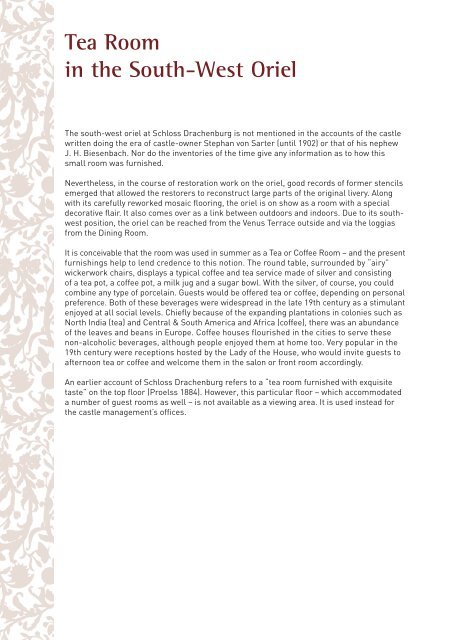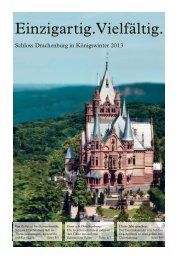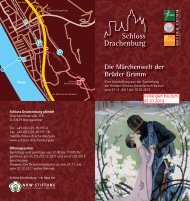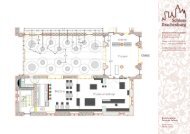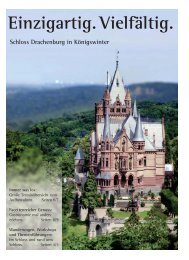North Tower - Schloss Drachenburg
North Tower - Schloss Drachenburg
North Tower - Schloss Drachenburg
Create successful ePaper yourself
Turn your PDF publications into a flip-book with our unique Google optimized e-Paper software.
Tea Room<br />
in the South-West Oriel<br />
The south-west oriel at <strong>Schloss</strong> <strong>Drachenburg</strong> is not mentioned in the accounts of the castle<br />
written doing the era of castle-owner Stephan von Sarter (until 1902) or that of his nephew<br />
J. H. Biesenbach. Nor do the inventories of the time give any information as to how this<br />
small room was furnished.<br />
Nevertheless, in the course of restoration work on the oriel, good records of former stencils<br />
emerged that allowed the restorers to reconstruct large parts of the original livery. Along<br />
with its carefully reworked mosaic fl ooring, the oriel is on show as a room with a special<br />
decorative fl air. It also comes over as a link between outdoors and indoors. Due to its southwest<br />
position, the oriel can be reached from the Venus Terrace outside and via the loggias<br />
from the Dining Room.<br />
It is conceivable that the room was used in summer as a Tea or Coffee Room – and the present<br />
furnishings help to lend credence to this notion. The round table, surrounded by “airy”<br />
wickerwork chairs, displays a typical coffee and tea service made of silver and consisting<br />
of a tea pot, a coffee pot, a milk jug and a sugar bowl. With the silver, of course, you could<br />
combine any type of porcelain. Guests would be offered tea or coffee, depending on personal<br />
preference. Both of these beverages were widespread in the late 19th century as a stimulant<br />
enjoyed at all social levels. Chiefl y because of the expanding plantations in colonies such as<br />
<strong>North</strong> India (tea) and Central & South America and Africa (coffee), there was an abundance<br />
of the leaves and beans in Europe. Coffee houses fl ourished in the cities to serve these<br />
non-alcoholic beverages, although people enjoyed them at home too. Very popular in the<br />
19th century were receptions hosted by the Lady of the House, who would invite guests to<br />
afternoon tea or coffee and welcome them in the salon or front room accordingly.<br />
An earlier account of <strong>Schloss</strong> <strong>Drachenburg</strong> refers to a “tea room furnished with exquisite<br />
taste” on the top fl oor (Proelss 1884). However, this particular fl oor – which accommodated<br />
a number of guest rooms as well – is not available as a viewing area. It is used instead for<br />
the castle management’s offi ces.


